|
|
news of Bible translation 2008
08.12.08
I
Workshop on completing the translation of the whole Bible
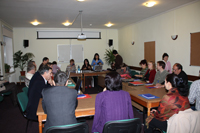 From
the 1st to the 8th of December a workshop was held outside Moscow
for translation teams that will soon finish the entire Bible in
their languages. Six teams participated – some from Central Asian
languages with several million speakers, others from smaller
people groups like the Tuvin. From
the 1st to the 8th of December a workshop was held outside Moscow
for translation teams that will soon finish the entire Bible in
their languages. Six teams participated – some from Central Asian
languages with several million speakers, others from smaller
people groups like the Tuvin.
There
were lessons on a variety of subjects, for example writing
an introduction to the Bible, ensuring consistency of key
terms, checking with the Paratext computer programme, reviewing
Old Testament citations in the New Testament, forming a
glossary, building a concordance, and adding cross-references.
Various other issues were also discussed, including the
revision of the New Testament in the light of the Old Testament,
stylistic checking of the whole Bible and a number of publishing
questions, such as format and supplementary materials. Among
the teachers were translation
consultants from IBT, UBS and SIL, as well as members of
the translation teams, and there were many useful and interesting
discussions.
The
publication of six entire Bibles within the next couple
of years will be the culmination of two decades of intense
work by these translation teams.
11.11.08
I
Official presentation of Bible translations in the languages
of Dagestan
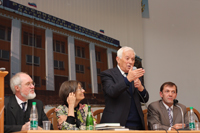 On
11 November 2008 a great celebration took place at the Academy of
Sciences in Makhachkala, capital of Dagestan in northern Caucasus
(Russia): the New Testaments in Avar and Kumyk were presented to
the public together with portions of the Bible in another ten
languages of Dagestan – Tabasaran, Lezgin, Lak, Dargin, Tsakhur,
Rutul, Agul, Bezhta, On
11 November 2008 a great celebration took place at the Academy of
Sciences in Makhachkala, capital of Dagestan in northern Caucasus
(Russia): the New Testaments in Avar and Kumyk were presented to
the public together with portions of the Bible in another ten
languages of Dagestan – Tabasaran, Lezgin, Lak, Dargin, Tsakhur,
Rutul, Agul, Bezhta,
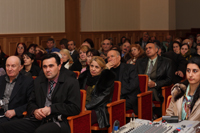 Kubachi
and Andi. Kubachi
and Andi.
Many
speakers addressed the full hall of the Academy. Professor Gadzhi
Gamzatov, who in 1991 signed an agreement on Bible translation
with IBT’s founder, Borislav Arapovic, recalled: “In the beginning
there was quite a lot of opposition, but this has calmed down and
now the work is regarded as
normal. Everyone is happy and grateful for the 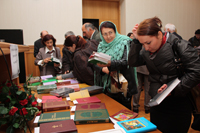 New Testaments in
Kumyk and Avar. I encourage you to read, read this book! Our
culture has been enriched through the Bible.” New Testaments in
Kumyk and Avar. I encourage you to read, read this book! Our
culture has been enriched through the Bible.”
Christianity
reached Dagestan as early as the first century, Islam came
much later;” the new director of the Institute of Languages
stated, “therefore the translation of the Bible belongs
to our culture and to our future.” “To our students
these New Testaments are excellent study material,”
said the rector of the Muslim theological institute. “But
I need to warn you that the worldview of Christianity differs
from the Muslim view. However, we trust that Professor Gamzatov
is doing the right thing and that these books will be useful
to our country.”
At
the end of the celebration when the participants were invited to
take books from the exhibition table, many people hurried to the
front, and the books quickly disappeared.
27.10.08
I
On 27 October the Children’s Bible in Khakas was launched
in Abakan, capital of Khakasia
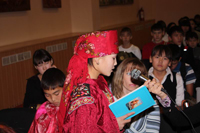 In
the morning a special feast for young readers was organized by the
Central Children’s Library for the children at a Khakas boarding
school in Abakan. A representative of the Ministry of Culture
spoke about the cultural importance of the Children’s Bible. Then
N. Gorbunova from IBT told the children that this book had been
translated into many other languages In
the morning a special feast for young readers was organized by the
Central Children’s Library for the children at a Khakas boarding
school in Abakan. A representative of the Ministry of Culture
spoke about the cultural importance of the Children’s Bible. Then
N. Gorbunova from IBT told the children that this book had been
translated into many other languages
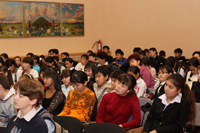 of
Siberia
–
Tuvin, Shor, Altai, Buryat, Evenki
–
and
that it was often used in schools. A priest from the Abakan
diocese stressed how important it was for children to get to know
the Holy Scriptures. Translators Ilya Topoev and Tatyana
Borgoyakova gave examples of some difficulties in Bible
translation, and Professor Karpov, language editor of the
translation, talked about the
necessity of resisting temptation, and how the Bible would help
the children in this respect. of
Siberia
–
Tuvin, Shor, Altai, Buryat, Evenki
–
and
that it was often used in schools. A priest from the Abakan
diocese stressed how important it was for children to get to know
the Holy Scriptures. Translators Ilya Topoev and Tatyana
Borgoyakova gave examples of some difficulties in Bible
translation, and Professor Karpov, language editor of the
translation, talked about the
necessity of resisting temptation, and how the Bible would help
the children in this respect.
Although it was only brief, we believe there was a real encounter
between the children and the book that will open the door to the
world of the Bible for them. For the teachers the Children’s Bible
in Khakas will be helpful
in
their teaching about world literature, history and art.
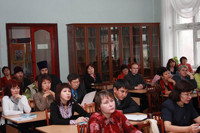 In
the afternoon a second presentation took
place in the National Library of Khakasia, with participants from
the cultural and
scientific circles of Abakan. All the speakers thanked IBT for the
gift
of the Children’s Bible and
stressed its importance for the
cultural and spiritual development of
Khakas society, especially for each individual child that would
come into contact with this book. The whole edition (3,000 copies)
was donated as a gift to the Khakas Republic. In
the afternoon a second presentation took
place in the National Library of Khakasia, with participants from
the cultural and
scientific circles of Abakan. All the speakers thanked IBT for the
gift
of the Children’s Bible and
stressed its importance for the
cultural and spiritual development of
Khakas society, especially for each individual child that would
come into contact with this book. The whole edition (3,000 copies)
was donated as a gift to the Khakas Republic.
10.10.08
I
IBT Helsinki published new Komi translation of New Testament
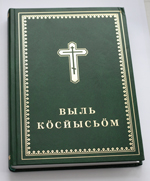 The
Institute for Bible Translation in Helsinki has completed the
translation of the New Testament in Komi, in cooperation with
Syktyvkar Diocese. The presentation was held on 3 October in
Syktyvkar, the capital of Komi Republic. The
Institute for Bible Translation in Helsinki has completed the
translation of the New Testament in Komi, in cooperation with
Syktyvkar Diocese. The presentation was held on 3 October in
Syktyvkar, the capital of Komi Republic.
According to Diocesan press secretary Fr. Philipp, the language of
the Bible versions in Komi published in the nineteenth century is
antiquated compared with the modern Komi language. “The new
translation of the Gospels in Komi is especially important to
people in the regions and villages where the Komi language is
used,” he said. “The book will be distributed mainly among
libraries, schools and colleges. Believers can obtain the Gospels
in churches and in the Diocese of Syktyvkar.”
29.09.08
I
From 24 to 26 September 2008 IBT and the Institute of Linguistics
of the Russian Academy of Sciences hosted a conference entitled
“Bible translation as a factor in preserving and developing the
languages of the Russian Federation and the CIS”.
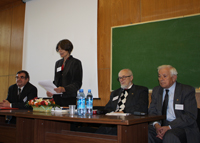 The
participants were welcomed by Mikhail Alekseev, deputy director
of the Institute of Linguistics, IBT’s directorMarianne
Beerle-Moor, and by Academicians E.P. Chelyshev and G.G.
Gamzatov of the Russian Academy of Sciences. In the greeting
sent by J.L. Vorotnikov, chairman of the Russian Scientific
Humanitarian Foundation, he noted that Bible translation
served as a powerful
impulse The
participants were welcomed by Mikhail Alekseev, deputy director
of the Institute of Linguistics, IBT’s directorMarianne
Beerle-Moor, and by Academicians E.P. Chelyshev and G.G.
Gamzatov of the Russian Academy of Sciences. In the greeting
sent by J.L. Vorotnikov, chairman of the Russian Scientific
Humanitarian Foundation, he noted that Bible translation
served as a powerful
impulse
 for
national, cultural and spiritual revival among the speakers
for whom the Bible was translated. for
national, cultural and spiritual revival among the speakers
for whom the Bible was translated.
During the three days of the conference about 30 speakers
read their papers –
linguists, translators, sociologists, biblical scholars
and historians from all over Russia and the CIS. Apart from
methodological problems connected
with translation, the
speakers
also analyzed its  sociological,
religious and
cultural aspects. Some s peakers
related their experiences of Bible translation into the
languages of Dagestan, Evenki, Roma, Ossetic, Komi-Permyak,
Khakas, Tajik, Yazgulyami, Shor, Bashkir, Udi and others. sociological,
religious and
cultural aspects. Some s peakers
related their experiences of Bible translation into the
languages of Dagestan, Evenki, Roma, Ossetic, Komi-Permyak,
Khakas, Tajik, Yazgulyami, Shor, Bashkir, Udi and others.
The
role of Bible translation for the preservation and development
of languages was discussed in many of the papers. At a time
when the languages of small ethnic groups are rapidly disappearing,
Bible translation often proves to be the only written monument
of a language and is regarded not only as a religious text,
but as a normative model, a source of replenishment and enrichment
of words and phrases. Bible translation stimulates the development
of the language and interest among the speakers for their
language; it raises the prestige of the language, which in
turn contributes to the revival of the people and their culture.
Marianne Beerle-Moor highlighted IBT’s Bible translations
into languages under threat of extinction. She also spoke
about the most recent and famous example of languages that
have been preserved thanks to Bible translation –
the recently discovered Caucasian Albanian manuscript in
old Udi, a language belonging to the Lezgin group of Dagestani
languages.
Many
of the speakers focused on practical questions of Bible
translation. G.V. Kostochakov stressed the value of the
Shor-Russian dictionary which is included in the Gospel
published in Shor. M.I. Magomedov mentioned the significant
role of Bible translation in non-written languages for the
spread of literacy among speakers of these languages.
The
participants expressed their great appreciation for the high
standard of the conference, its organization and the papers which
were read, which resulted in many lively and interesting
discussions.
19.09.08
I
The first New Testament in Avar published
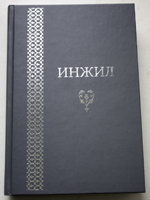 On
19 September 2008 the first copies of the New Testament in Avar
were delivered to IBT’s office in Moscow. The Avars (about
800,000) are the largest people group in Dagestan, northern
Caucasus. There are also Avars in northern Azerbaijan and in
Turkey. This is the first New Testament ever published in their
language – a historic event! The translation team has been working
on the translation for 17 years. On
19 September 2008 the first copies of the New Testament in Avar
were delivered to IBT’s office in Moscow. The Avars (about
800,000) are the largest people group in Dagestan, northern
Caucasus. There are also Avars in northern Azerbaijan and in
Turkey. This is the first New Testament ever published in their
language – a historic event! The translation team has been working
on the translation for 17 years.
The
Avar language belongs to the North Caucasian family and is used in
many areas of Dagestan as the language of communication between
various ethnic groups. The Avars began to write down texts in
their language as early as the 17th century
– earlier
than
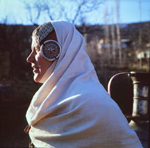 any
other people group of Dagestan. any
other people group of Dagestan.
Together with other ethnically related peoples, the Avars formed
part of one of the earliest known Christian states, namely
Caucasian Albania, and from the 4th century onwards
Christianity was widespread among them. However, as the Middle
Ages wore on, the Avars came under the influence of Islam and
their life and culture became thoroughly islamicised. Today they
are Sunni Muslims.
The first Bible portion in Avar, John's Gospel, was published by
IBT in 1979, Mark's Gospel in 1996 and Luke & Acts in 2000.
Proverbs was published in 2005. Translation work into Avar is
continuing with other parts of the Old Testament.
In November 2008 there will be a celebration of the Bible
books so far published in 12 languages of Dagestan: New
Testaments in Avar and Kumyk, books from the New and Old
Testaments in Tabassaran, Lezgin, Lak, Dargin, Tsakhur,
Rutul, Agul, Bezhta, Kubachi and Andi. The event will be
arranged by IBT and the Institute of Language, Literature
and Art of the Academy of Sciences, Dagestan, and will take
place in the capital, Makhachkala.
12.09.08
I
Children’s Bible in Khakas
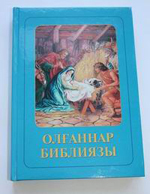 In
September 2008 the Institute for Bible Translation published the
Children’s Bible in the Khakas language. This is the thirty-fifth
translation of IBT’s well-known Bible for Children, first
published 25 years ago in Russian. Since then this book has been
translated into several non-Slavic languages of Russia and the
CIS. For many people it has become their first step in getting to
know the Holy Scriptures. In
September 2008 the Institute for Bible Translation published the
Children’s Bible in the Khakas language. This is the thirty-fifth
translation of IBT’s well-known Bible for Children, first
published 25 years ago in Russian. Since then this book has been
translated into several non-Slavic languages of Russia and the
CIS. For many people it has become their first step in getting to
know the Holy Scriptures.
The
translation of the Children’s Bible into Khakas, which began in
2002, was carried out by a team of five, four of whom were Khakas.
The first edition is of 3,000 copies, and the books have already
arrived in
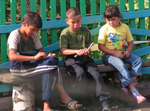 Khakasia.
They will be distributed to libraries, schools and churches, so
that as many readers as possible will be acquainted with this new,
beautifully illustrated book in the Khakas language. Khakasia.
They will be distributed to libraries, schools and churches, so
that as many readers as possible will be acquainted with this new,
beautifully illustrated book in the Khakas language.
In October there will be an official presentation of the
Children’s Bible in Abakan, the capital of Khakasia,
arranged by IBT together with the Ministry of Culture and
the Ministry of Education and Science of the Khakas Republic.
The first part of the presentation will be with children
of a Khakas boarding school, while the second part will
be a roundtable discussion with writers, teachers and other
representatives of Khakas society.
16.06.08
I
The
Four Gospels and Acts in Crimean Tatar
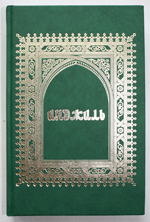 In
the summer of 2008 the Four Gospels and Acts were published
in Crimean Tatar for the first time. In
the summer of 2008 the Four Gospels and Acts were published
in Crimean Tatar for the first time.
The Crimean
Peninsula is the historic homeland of the Crimean Tatars. However,
in 1944 they were accused of being Nazi collaborators and deported
to Central Asia and other areas of the Soviet Union. Many died of
disease and malnutrition. For a long time the Crimean Tatars were
not recognised as a distinct ethnic group, they were deprived of
all rights, with no freedom to travel. Only in 1989 did the Soviet
Union allow the Crimean Tatars to return to Crimea. Today more
than 250,000 Crimean Tatars are back in their homeland, struggling
to reestablish their lives and reclaim their national and cultural
rights, including the use of their language, against many social
and economic obstacles.
The first attempt to
translate the Bible into Crimean Tatar took place during the
period 1978-1996. In 1999 a translation group was established
locally and since then several Bible books have been published
(“Stories of Jesus”, illustrated by a national artist, in 2002; a
book on the prophets in 2005; a revision of Matthew’s Gospel in
2006, and a book containing Proverbs and Ecclesiastes in 2007).
The work is done in cooperation with the Pioneer Bible Translators
and the Ukrainian Bible Society.
The Crimean Tatars are hungry
for spiritual literature and the books published so far
have been well received. Our hope is that the Four Gospels
and Acts will be a great blessing to the Crimean Tatars.
15.05.2008
I
"In the beginning was
the Word”. Easter Prologue Polyglot
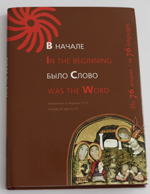
For
Easter 2008 IBT Russia/CIS published a book containing the
first seventeen verses of John’s Gospel in 76 languages – some of
them are ancient, as Koine Greek, Syriac, Latin and Church
Slavonic, while others are modern languages spoken or used in
Russia.
Every Easter night, in the Russian Orthodox Church tradition,
these verses are read in many languages. Easter is the oldest
feast of the Church and has always been celebrated on the night
between Holy Saturday and Easter Day. From the third century it
was the night when new believers were baptized and received into
the community of faith.
The
tradition of reading John 1:1-17 goes back to the tenth century
and is believed to have been initiated by the Bishop of
Constantinople. From the very beginning it was read in two
languages, Latin and Greek. Hebrew was added to this reading as
the third language used in the inscription on the cross: “Jesus of
Nazareth, King of the Jews”. When local languages started to be
used in the liturgy, the text was read in these languages, too.
In
Russia today the Prologue is read in these ancient languages and
in several modern ones. There is a symbolic significance: the good
news of Christ whose victory over death is celebrated especially
on Easter night is meant to be heard in all languages of the
globe.
We
hope that this book will make it possible for the churches
to read John 1:1-17 in many “new” languages,
especially in those which have previously had no Bible translation.
21.03.2008
I
Basic training course for Bible translation
 From
11 to 21 March within the framework of a new educational program
the Institute for Bible Translation held its first intensive basic
training course in Moscow for translation team members. Taking
part were twelve people from nine translation projects (Ingush,
Kabardian, Lezgi, Erzya-Mordvin, Moksha-Mordvin, Nogai, Tabassaran
and from Central Asia), including translators, exegetical
checkers, philological and From
11 to 21 March within the framework of a new educational program
the Institute for Bible Translation held its first intensive basic
training course in Moscow for translation team members. Taking
part were twelve people from nine translation projects (Ingush,
Kabardian, Lezgi, Erzya-Mordvin, Moksha-Mordvin, Nogai, Tabassaran
and from Central Asia), including translators, exegetical
checkers, philological and
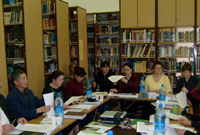 stylistic
editors and also one local coordinator. They attended sessions on
introduction to the Old and New Testaments, the historical and
cultural context, linguistics, translation theory, exegesis,
testing, philological editing and organisation of the translation
process from IBT staff, lecturers from a Moscow theological
college and professors from the Institute of Linguistics (Russian
Academy of Sciences). stylistic
editors and also one local coordinator. They attended sessions on
introduction to the Old and New Testaments, the historical and
cultural context, linguistics, translation theory, exegesis,
testing, philological editing and organisation of the translation
process from IBT staff, lecturers from a Moscow theological
college and professors from the Institute of Linguistics (Russian
Academy of Sciences).
The participants’ feedback was encouraging: “The workshop has
challenged me to learn more, to know the source text better; it
has captivated me and made me more interested in the subject of
Bible translation.” “After the workshop I wanted to change a lot
in my translation.” “I’m happy that after this seminar I can make
my own small impression on my project and help the rest of the
team members.”
Following this success IBT is now considering the
possibility of holding a more advanced course.
05.03.2008
I
Presentation
of the Mari New Testament
 On
4 February the New Testament («U Sugyn»)
in the Eastern Mari language was launched at the National
Library in the city of Yoshkar-Ola. The translation was
by the Institute for Bible Translation, Helsinki.At
this important celebration in the life of the Mari El Republic
a large gathering heard speeches by Archbishop John of Yoshkar-Ola
and Mari El, Minister of Culture Mikhail Vasyotin, and On
4 February the New Testament («U Sugyn»)
in the Eastern Mari language was launched at the National
Library in the city of Yoshkar-Ola. The translation was
by the Institute for Bible Translation, Helsinki.At
this important celebration in the life of the Mari El Republic
a large gathering heard speeches by Archbishop John of Yoshkar-Ola
and Mari El, Minister of Culture Mikhail Vasyotin, and
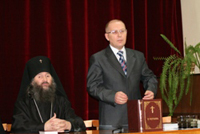
Professors
Ksenofont Sanukov and Sergey Starikov. They stressed the
importance of the translation of the Holy Scriptures into
Eastern Mari, in the context of the historical-spiritual
development of the Mari people and of the other peoples
in the Mari El Republic.
This
was followed by greetings from the
 guests
who had travelled to Yoshkar-Ola
for the celebration
–
Director of Finno-Ugric
branch of the Institute for Bible Translation
in Helsinki, Anita Laakso, theological editor Tiina Ollikainen
and translator Leonid Yandakov. guests
who had travelled to Yoshkar-Ola
for the celebration
–
Director of Finno-Ugric
branch of the Institute for Bible Translation
in Helsinki, Anita Laakso, theological editor Tiina Ollikainen
and translator Leonid Yandakov.
The
leader of the translation commission in the Yoshkar-Ola
and Mari Diocese, Rev. Nikolai Chuzayev, read the Lord's
Prayer from the new Eastern Mari translation.
Website of
the Russian Orthodox Diocese of Yoshkar-Ola
|
Share: